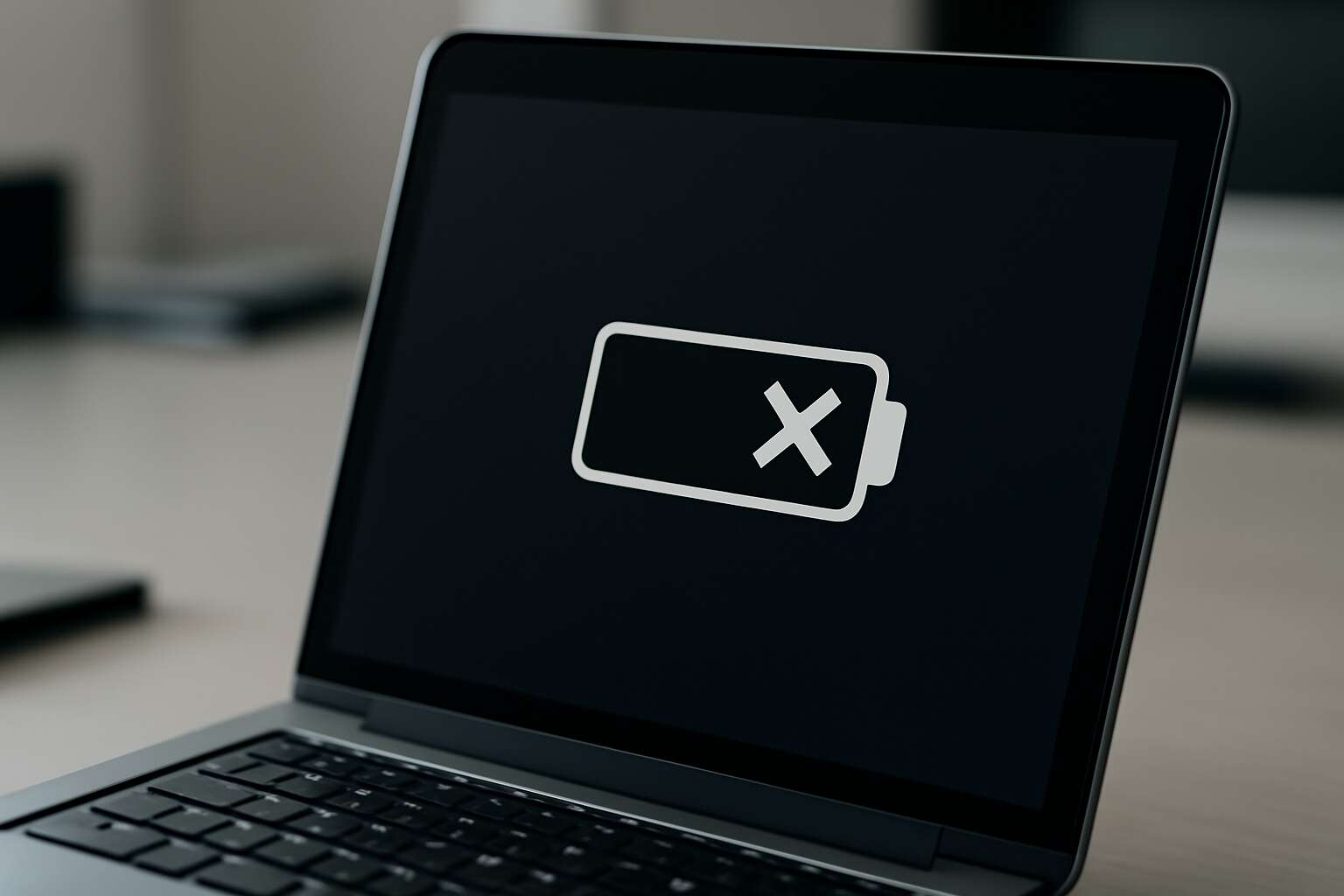Understanding Laptop Battery Indicators
What Does the Battery Mark Mean? – Interpreting different battery icons and their significance
In the labyrinth of modern technology, the laptop battery has x mark, acting as a silent sentinel that communicates more than mere capacity—it echoes the delicate balance of power and vulnerability within our devices. When we glance at these icons, they reveal a language of their own, a visual lexicon that can mean the difference between seamless productivity and sudden shutdowns. Understanding what each battery icon signifies is crucial, especially when the laptop battery has x mark, indicating a specific state that warrants attention.
Icons vary from simple battery bars to complex symbols, each embodying a distinct message about your device’s energy reserve. For example, a battery with a lightning bolt suggests charging, while a half-full battery may signal that your power is waning but still sufficient for a while. But what about the moments when the laptop battery has x mark? This particular icon often hints at a critical issue—perhaps the battery’s health has declined, or there’s a connection problem that requires investigation. Recognizing these signs allows users to interpret the significance of different battery icons with clarity and confidence.
Common Battery Mark Symbols Explained – Overview of X, full, half-filled, and other marks
In the realm of digital whispers, the sight of the laptop battery has x mark is an enigmatic signal—an unspoken plea from your device that something is amiss. While the icons we see are often simplistic, their meanings are layered with silent stories of power and vulnerability, whispering secrets only the discerning can interpret. The x mark, in particular, acts as a cryptic emblem, hinting at a critical juncture where the battery’s health may be compromised or a connection falters.
Understanding what each battery indicator signifies is akin to learning a secret language—an essential skill for maintaining seamless productivity. The full battery icon suggests ample energy, while a half-filled symbol indicates the battery is waning but still resilient. But when the laptop battery has x mark, it often signals a more urgent concern—perhaps the battery is failing, or there’s an internal error that demands attention. Recognizing these icons isn’t just about convenience; it’s about safeguarding your device’s vitality in a rapidly evolving digital landscape.
Why Battery Marks Matter for Users – Impacts on device performance and maintenance
In the bustling world of digital productivity, a blinking or static icon on your laptop might seem trivial—until it isn’t. When your device’s battery has x mark, it’s as if your laptop is whispering, “Houston, we have a problem.” This small but mighty indicator can drastically impact device performance, acting as the digital equivalent of a red flag. Recognising what this symbol means isn’t just about avoiding surprise shutdowns; it’s about preemptively addressing maintenance issues before they morph into costly repairs.
Understanding why the battery marks matter is crucial for every South African laptop user who relies on their device for work, study, or streaming the latest cricket match. The presence of a laptop battery has x mark might hint at underlying problems like internal battery degradation or connection faults. Ignoring these signs could lead to diminished battery lifespan and overall performance. Keep a keen eye on these indicators, and you’ll stay one step ahead in the game of digital endurance.
Types of Battery Marks and Their Implications
X Mark Indication on Laptop Batteries – What an X mark signifies about your battery
When your laptop battery has an X mark, it signals a warning that shouldn’t be ignored. Unlike the simple icons that indicate battery levels or charging status, an X mark often points to a more serious issue—one that could jeopardize your device’s reliability. This symbol is a stark visual cue, echoing through the device’s interface, that your battery may be compromised or nearing the end of its lifespan.
Understanding the implications of an X mark on your laptop battery is crucial. It typically suggests a failure in the battery’s ability to hold a charge or a hardware malfunction that requires attention. Such a mark can appear due to aging, overheating, or even manufacturing defects. Recognizing this early can prevent unexpected shutdowns and data loss, especially when your work or personal projects depend heavily on your device.
Battery Health Status Indicators – Understanding battery condition through marks
In the realm of digital guardianship, understanding the subtle language of your laptop battery can be the difference between seamless productivity and unforeseen chaos. When the laptop battery has X mark, it whispers a silent warning—an enigmatic sign that your device’s vitality is waning. These marks, more than mere symbols, are the language of the battery’s health, revealing its true condition beneath the surface.
Battery health status indicators come in various forms, each telling a unique story. Some marks signal aging, while others hint at overheating or hardware malfunctions. For instance, a battery marked with an X often indicates a critical failure, possibly due to persistent overheating or manufacturing imperfections. Recognizing these signs early helps prevent abrupt shutdowns and data loss, safeguarding your valuable work and personal memories.
Understanding the different battery marks is akin to deciphering a secret code—each symbol a clue to the device’s inner workings. An X mark on a laptop battery signifies that the battery’s capacity has diminished significantly or that it’s no longer reliable for daily use. This visual cue serves as a vital checkpoint, urging users to consider replacement or professional inspection before further complications arise.
In the end, the marks on your laptop battery are not just icons—they are the silent sentinels of your device’s health, guiding you through the delicate dance of maintenance and care. When the laptop battery has X mark, it’s a call to action—an invitation to ensure your digital companion remains steadfast and dependable for the journeys ahead.
Signs of Battery Degradation or Damage – Identifying potential issues from battery marks
When your laptop battery has an X mark, it’s like a red flag waving in the digital wind. But what exactly do these marks signify? Understanding the various battery marks can be the difference between a quick fix and a costly replacement. For example, a battery with an X mark often indicates severe degradation or imminent failure, revealing that the battery can no longer hold a reliable charge. This isn’t just a minor hiccup—it’s a sign that your device might be playing dead soon.
Signs of battery degradation or damage are often hidden beneath the surface, but these marks offer a visual cue. A battery that displays an X mark typically suggests issues such as overheating, manufacturing defects, or accumulated wear and tear. Recognizing these signs early can save valuable data and prevent sudden shutdowns. In some cases, an X mark may be accompanied by other indicators like reduced capacity or erratic charging behavior, further highlighting the urgency for inspection.
Understanding the implications of these marks is crucial, especially for those relying heavily on their laptops for work or study. An X mark is more than just an icon—it’s a warning sign that your battery’s health has taken a nosedive. If the laptop battery has X mark, it’s time to consider professional diagnosis or replacement, ensuring your device remains dependable when you need it most.
Diagnosing and Troubleshooting a Laptop Battery with an X Mark
Common Causes for an X Mark on Battery – Hardware issues, software glitches, or calibration problems
When your laptop battery has an X mark, it can feel like a warning from the digital gods—an ominous sign that something is amiss. Diagnosing this issue requires a keen eye and a touch of curiosity. Often, the culprit lies in hardware issues, such as a faulty connection or a deteriorating battery cell. But don’t overlook software glitches or calibration problems, which can also cast a shadow over your device’s vitality.
To unravel the mystery behind the X mark, begin by checking the battery’s health status indicators—these can reveal whether the battery is genuinely failing or if a simple recalibration might restore its function. Sometimes, the X mark appears due to calibration problems, where the battery’s internal sensors misreport its status, leading to confusing signals. If software glitches are suspected, updating your device’s firmware or reinstalling battery management drivers can often clear the obstruction.
Understanding the common causes for an X mark on battery is essential for maintaining optimal performance. Hardware issues, such as physical damage or age-related wear, are frequent culprits, but a thorough troubleshooting process can often pinpoint the root cause. Identifying these triggers not only prolongs the lifespan of your laptop battery but also ensures your device remains a trusted companion on your daily adventures.
Steps to Confirm Battery Status – Utilizing diagnostics tools and battery health reports
When your laptop battery has an X mark glaring at you like a bad omen, it’s time for some detective work. But how do you confirm if the issue is serious or just a minor hiccup? The secret lies in leveraging diagnostic tools and battery health reports—your digital magnifying glass. Many modern laptops come with built-in diagnostics, accessible via BIOS or system settings, which can reveal the true state of your battery. These reports often display detailed metrics such as capacity, cycle count, and overall health, helping you decipher whether that X mark signals imminent failure or a simple glitch.
To get started, access your device’s battery health report—often found in your device’s control panel or system diagnostics. Look for indicators like design capacity versus current capacity and cycle count. If your laptop battery has X mark, a quick check of these numbers can reveal if the battery is truly on its last legs. Sometimes, recalibrating the battery by fully charging and discharging it can reset the internal sensors, which might be enough to make that X disappear and restore normal operation.
- Run built-in diagnostics or use third-party battery health tools for a comprehensive report.
- Compare the reported capacity with the original design capacity—significant discrepancies suggest deterioration.
- Check the cycle count—most batteries have a limited number of charge cycles before they start to deteriorate.
If these steps confirm that your laptop battery has x mark and is beyond simple remedies, replacing the battery might be the only way forward. But don’t jump to conclusions—sometimes, a little troubleshooting can extend your battery’s lifespan and keep that X mark at bay a little longer!
When to Seek Professional Repairs – Indicators that require expert intervention
When the sight of a laptop battery has X mark appears on your screen, it’s as if a silent warning from the digital realm itself. The question then arises: should you panic, or can this be tamed through careful diagnosis? Often, this mark signals underlying issues that require the keen eye of troubleshooting.
In such moments, professional diagnostics become indispensable. Running built-in diagnostics or trusted third-party battery health tools reveals the hidden story of your battery’s vitality. Look beyond the surface—compare the current capacity with the original design capacity, and scrutinize the cycle count. These indicators serve as the oracle, guiding you to whether the X mark is a fleeting glitch or a harbinger of impending failure.
If the diagnostics reveal that your laptop battery has X mark and the numbers tell a tale of degradation, it may be time for a replacement. However, sometimes recalibration or a simple reset of the internal sensors can make that X vanish, restoring harmony within your device. Only when these measures prove futile should you seek professional repairs, for a battery in decline demands expertise and precision.
How to Fix a Laptop Battery Marked with X
Performing Battery Calibration – Steps to recalibrate your battery for accurate markings
A laptop battery has X mark can be a frustrating sight, especially when it disrupts your workflow. Often, this symbol indicates the need for a recalibration to restore accurate battery readings. Calibration helps your system better understand the battery’s true capacity, ensuring your device displays reliable information.
Performing a battery calibration is straightforward. Start by fully charging your laptop to 100%, then disconnect it and use it normally until it automatically shuts down due to low battery. Next, plug it back in and keep it charging for an additional two hours. Once complete, restart your laptop and let it discharge to around 5%. Recharge fully without interruption.
This process can often fix a laptop battery has x mark issue, providing more precise battery status readings. Regular calibration is a simple yet effective way to maintain optimal battery health and prevent unnecessary replacements.
Replacing the Battery – When and how to replace a failing battery
When the ominous sight of a laptop battery has X mark appears on your screen, it often signals more than just a minor glitch—it’s a herald that your power source may be nearing its twilight. In the realm of modern technology, batteries are the lifeblood of portable devices, and recognizing when it’s time to replace the battery can save you from unexpected shutdowns in the midst of crucial tasks.
If your laptop battery has X mark, the first step isn’t immediate replacement but a careful assessment of its true condition. Sometimes, calibration can restore its vigor, but persistent X marks indicate deeper issues. When the battery’s capacity diminishes beyond practical repair, replacing the battery becomes the wise choice.
Knowing exactly when to replace a failing battery is crucial. Look out for signs such as rapid discharging, swelling, or persistent inaccuracies in power readings. For many, a failing battery with an X mark is a clarion call—an invitation to seek a new energy core. Whether you choose a professional repair or a DIY replacement, ensuring your device’s health remains paramount.
Updating BIOS and Drivers – Ensuring software is not causing false battery marks
In the shadowed corridors of modern technology, a flickering X mark on your laptop battery can feel like a warning from the abyss itself. Before rushing into replacement, consider that sometimes, the specter of a failing battery is a false prophecy born from software mischief. Updating BIOS and drivers might just dispel the ominous X mark, restoring harmony between hardware and digital spirits.
Begin by ensuring your system’s firmware and device drivers are up to date. Outdated BIOS versions or faulty drivers can conjure misleading battery health indicators, including the dreaded laptop battery has X mark. To perform this ritual, visit your manufacturer’s website and download the latest updates, then follow their sacred instructions to install them.
Once updated, run diagnostic tools to scrutinize the battery’s true condition. If the laptop battery has X mark persists despite software updates, it’s time to investigate further. Sometimes, calibration or a simple reset can banish the false X, but beware—if the mark remains, the true malady might be hardware’s silent decay.
Preventing Battery Mark Errors and Extending Battery Life
Best Practices for Battery Maintenance – Proper charging habits and storage tips
In the delicate dance between technology and longevity, preventing battery mark errors becomes paramount. A misinterpreted mark, such as a laptop battery has x mark, can lead users astray, causing unnecessary concern or premature replacements. To avoid this, proper charging habits are essential. Overcharging or letting the battery drain completely can accelerate degradation, subtly influencing the battery’s capacity to hold a charge. Storage tips also play a crucial role; storing your device in a cool, dry environment preserves battery health and prevents false X marks from appearing due to temperature fluctuations or prolonged inactivity.
Extending battery life isn’t solely about avoiding errors—it’s about adopting best practices for maintenance. For instance, calibrating your battery periodically helps maintain accurate status indicators, including any X marks. It’s wise to keep your BIOS and drivers updated, as software glitches often cause false battery mark readings. Additionally, adopting a balanced charging routine—charging to around 80%, then unplugging—can significantly slow down wear and tear. Remember, the goal is to nurture your device, respecting its natural rhythms rather than forcing it to operate beyond its designed lifespan.
Using Power Management Settings Effectively – Optimizing laptop settings to prolong battery health
Optimizing power management settings on your laptop is a subtle art that can significantly prolong battery health and prevent confusing battery mark errors. In a world where device uptime is vital, understanding how to effectively manage these settings can be a game-changer. When you configure your power options correctly, you minimize unnecessary strain on your battery, reducing the likelihood of encountering a laptop battery has x mark prematurely. This small adjustment can help maintain accurate battery status indicators, giving you peace of mind about your device’s longevity.
To enhance battery performance, consider tailoring your device’s sleep and hibernate modes, dimming the display when not in use, and disabling background apps that drain power. For a more strategic approach, you might employ a balanced charging routine—charging to about 80% and unplugging—an often-overlooked practice that can slow down battery wear and tear. Such proactive management ensures that the battery remains in optimal condition, avoiding false X marks that can cause unnecessary alarm or prompt premature replacements.
In addition, adjusting your laptop’s power management settings through the control panel or system preferences can be a discreet yet effective measure. These configurations help prevent excessive power drain during idle periods and reduce the risk of hardware or software glitches that might cause a laptop battery has x mark to appear. Thoughtful use of these settings is essential for those who wish to preserve their device’s vitality and keep battery mark readings accurate for as long as possible.
Monitoring Battery Performance Over Time – Tools and methods for ongoing health checks
Monitoring your laptop battery’s health over time is crucial to avoid unexpected failures and costly replacements. While the “laptop battery has x mark” can seem like a minor inconvenience, it often signals underlying issues that, if left unchecked, may lead to diminished device performance. To prevent these battery mark errors from sneaking up on you, employing robust tools like battery health diagnostics and system monitoring software is essential. These tools not only reveal real-time status but also track performance trends, offering insight into when your battery might need attention.
Regularly checking your battery’s performance through built-in system reports or specialized apps can uncover subtle signs of degradation. For instance, a sudden change in capacity or frequent recalibrations often precede the appearance of a “laptop battery has x mark.” An ordered approach—such as scheduled health scans—helps catch issues early, ensuring you’re not caught off guard by sudden battery failures. With vigilant monitoring, you can extend the lifespan of your battery and keep that confusing x mark from turning into a costly surprise.




0 Comments